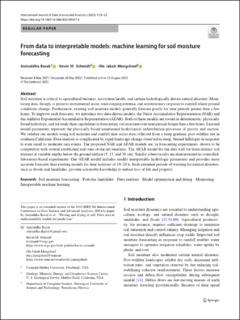| dc.description.abstract | Soil moisture is critical to agricultural business, ecosystem health, and certain hydrologically driven natural disasters. Monitoring data, though, is prone to instrumental noise, wide ranging extrema, and nonstationary response to rainfall where ground conditions change. Furthermore, existing soil moisture models generally forecast poorly for time periods greater than a few hours. To improve such forecasts, we introduce two data-driven models, the Naive Accumulative Representation (NAR) and the Additive Exponential Accumulative Representation (AEAR). Both of these models are rooted in deterministic, physically based hydrology, and we study their capabilities in forecasting soil moisture over time periods longer than a few hours. Learned model parameters represent the physically based unsaturated hydrological redistribution processes of gravity and suction. We validate our models using soil moisture and rainfall time series data collected from a steep gradient, post-wildfire site in southern California. Data analysis is complicated by rapid landscape change observed in steep, burned hillslopes in response to even small to moderate rain events. The proposed NAR and AEAR models are, in forecasting experiments, shown to be competitive with several established and state-of-the-art baselines. The AEAR model fits the data well for three distinct soil textures at variable depths below the ground surface (5, 15, and 30 cm). Similar robust results are demonstrated in controlled, laboratory-based experiments. Our AEAR model includes readily interpretable hydrologic parameters and provides more accurate forecasts than existing models for time horizons of 10–24 h. Such extended periods of warning for natural disasters, such as floods and landslides, provide actionable knowledge to reduce loss of life and property. | en_US |

